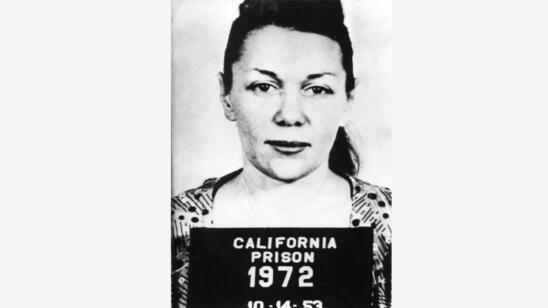When Lindsay Haugen met Robby Mast at a house party on August 20, 2015, she immediately knew she’d met someone special.
“There was this beautiful smile sitting in a big pile of empty beer cans on the floor, with no shirt on, and dreadlocks… just very carefree,” she recalls with a smile. “There was just kinda this instant connection.”
But on September 15—less than four weeks later—she strangled Mast to death while the two sat in her car in a Walmart parking lot in Billings, Montana.
What drove Haugen, then 32 years old, to end her new paramour’s life? That’s the central question behind Season 2, Episode 1 of “I Am a Killer” available on Netflix on January 20, 2020. The show—which first premiered in 2018—is a series of hour-long episodes that profile different convicted killers via straight-to-camera interviews with investigators, the families of victims and the killers themselves. The second season originally aired on A+E Networks’ Crime + Investigation channel in the UK in 2019.
Immediately prior to getting together with Mast, Haugen had been the victim of a violent relationship. Her partner repeatedly raped her, broke her hand and choked her unconscious before finally being jailed for abuse in June 2015—only two months before she and Mast met.
Mast was vagabond, hopping freights and hitchhiking about the country. Haugen was in love, so shortly after meeting him, she agreed to travel together, setting off from Washington state.
Haugen said that while they were on the road, Mast revealed that he was deeply suicidal, and he began repeatedly asking her to take his life. Eventually, she said, she acquiesced to the request.
“One day he looked at me and said, ‘Lindsay, I’m tired… I just want to die,'” Haugen says. “So I said, ‘I know of a way to do it, and it won’t hurt. You’ll just go unconscious and then you won’t wake up.’ And he looked at me, and his eyes sparkled, and he said, ‘You would do that for me?’ I said, ‘Robby, I love you. I would do anything for you.'”
After allegedly waffling for “about a week,” Haugen killed Mast with a “rear naked choke.”
“I put my arms around his neck and then he just bowed his head. When I started I didn’t feel like I could really do it. I squeezed and I could tell it wasn’t really hard enough… he shook, and I thought maybe he was waking up and maybe he was going to stop me. But then he stopped.”
After buckling Mast’s corpse into the passenger seat, Haugen started driving before being stopped by local law enforcement. She confessed immediately to the killing with the aforementioned motivation.
Steve Hallam, the detective of the Billings Police Department who interrogated Haugen, doesn’t buy her version of events.
“Very rarely, if ever, have I ever heard… somebody asking somebody else to kill them,” Hallam says. “If somebody wants to end their life, there are plenty of other ways to do it.”
He further states that Haugen lied at various points in her interrogation, noting that at one point she claimed that Mast pulled Haugen’s hands back onto his throat when he was on the precipice of death. That, he says, is impossible.
In a taped interrogation, Hallam challenged Haugen on her motive.
“I buy how it happened… I don’t buy that he was unhappy and he was begging you to take his life,” he tells her on the tape.
“No, that’s absolutely what happened… but yes: I kind of just wanted to kill someone with my bare hands, honestly,” she replies.
Haugen pleaded guilty to deliberate homicide and was sentenced to 60 years imprisonment in Yellowstone County, Montana District Court. Despite her crime, Haugen has some defenders: notably, Dori and Gene Greeson, the mother and stepfather of her victim, Robby Mast.
The Greesons, who are devout Christians, say they leaned on their faith to forgive Haugen, and that that forgiveness opened a pathway to regular correspondence with their son’s killer. The couple have visited Haugen at Montana State Women’s Prison, and they regularly communicate via video chat.
“I was able to forgive Lindsay because I know I am forgiven by God,” Dori Greeson says. “The person who took my son’s life, her just saying ‘I’m so sorry,’ and receiving our forgiveness—she’s been an example of how I need to be with my savior, the one who has forgiven me.”
Some might find that level of compassion misguided, a judgment that isn’t lost on Dori Greeson.
“When others would say to me ‘I would never be able to forgive someone who killed my child,’ I felt they were saying it like I was betraying him.”
As for Haugen, there’s benefit to maintaining a relationship with the Greesons. She’ll have her first parole hearing in 2030, and the attitudes of the victim’s family carry weight with parole boards.
Detective Hallam remains convinced that Haugen’s story is bogus: Robby Mast’s friends met the couple two days before Mast was murdered, where the pair had a fight about one of Robby’s ex-girlfriends, whom they say he still harbored feelings for.
But the way Gene Greeson speaks about the murder, it’s as if the circumstances are immaterial.
“I know there are some who doubt whether Lindsay is being totally honest,” Gene Greeson says. “The bottom line is: let’s say that it was premeditated and with malice and so forth—I’d still believe our place is to forgive her.”
Related Features:
‘I Am a Killer’ Interviews Miguel Martinez and Miguel Venegas About Their Roles in Satanic Murders
The ‘Kayak Killer’ and Other Criminals Who Capitalized on Their Crimes
The Murder of Helen Potts: How Carlyle Harris, a Wealthy Med Student, Poisoned His Secret Wife


